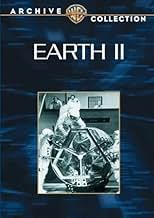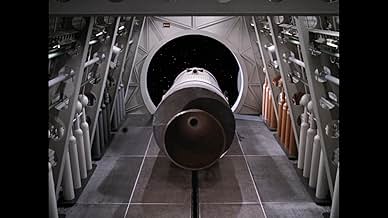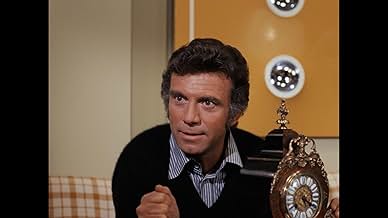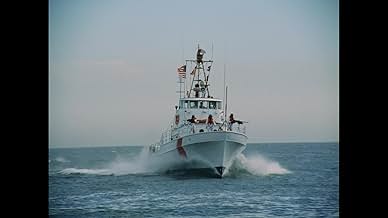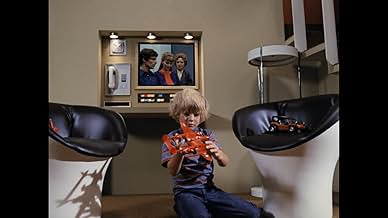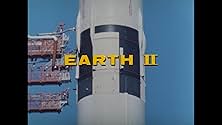PUNTUACIÓN EN IMDb
5,6/10
411
TU PUNTUACIÓN
Añade un argumento en tu idiomaWhen Earth II, an orbiting research space station, is menaced by a Red Chinese nuclear weapon, its 2,000 inhabitants take action to disarm and dispose of the missile without resorting to vio... Leer todoWhen Earth II, an orbiting research space station, is menaced by a Red Chinese nuclear weapon, its 2,000 inhabitants take action to disarm and dispose of the missile without resorting to violence.When Earth II, an orbiting research space station, is menaced by a Red Chinese nuclear weapon, its 2,000 inhabitants take action to disarm and dispose of the missile without resorting to violence.
- Dirección
- Guión
- Reparto principal
Anthony Franciosa
- Frank Karger
- (as Tony Franciosa)
Edward Michael Bell
- Anton Kovalefskii
- (as Edward Bell)
Reseñas destacadas
This was sort of a cross between 2001 and Marooned. It made a very early attempt to make a scientifically accurate sci-fi series. The station was populated by people from all nations. They set up thier own government, and they led very politically correct lives. Any adult could disagree with the station's government and put the disagreement to a vote via an interactive TV. The show had some very interesting ideas about the future development of technology. Early in the show, a national election takes place by people turning on their home lights, and an spaceship in orbit counts the votes. Worth seeing if you can.
I saw this TV-movie when it aired in 1971. I liked it then and saw it a few times in syndication. Now I own it on DVD.
The premise is that an orbiting space station is created by the United States and then is set up as an independent nation named Earth II. This nation is completely democratic, with a council that executes policies for the station. If someone disagree, they can challenge that decision and all the citizens can vote.
A situation occurs where the "no weapons" policy is challenged. A nuclear bomb is orbit around Earth, and passes close to the station on every orbit. The citizens have to make a choice whether to interfere with the bomb, in order to protect themselves and Earth.
The movie stars Gary Lockwood of "2001: A Space Odyssey" fame, Hari Rhodes and Scott Hylands. In a supporting role is Gary Merrill. Since this was probably a pilot, the guest cast included Tony Franciosa and Mariette Hartley.
While the film is dated and some of the science not so accurate, it is still very well done and for science fiction fans, should be seen.
One complaint is that there are two excellent actors playing Chinese representatives. These are Soon-Tek Oh and James Hong. They are uncredited, which is unfortunate.
The premise is that an orbiting space station is created by the United States and then is set up as an independent nation named Earth II. This nation is completely democratic, with a council that executes policies for the station. If someone disagree, they can challenge that decision and all the citizens can vote.
A situation occurs where the "no weapons" policy is challenged. A nuclear bomb is orbit around Earth, and passes close to the station on every orbit. The citizens have to make a choice whether to interfere with the bomb, in order to protect themselves and Earth.
The movie stars Gary Lockwood of "2001: A Space Odyssey" fame, Hari Rhodes and Scott Hylands. In a supporting role is Gary Merrill. Since this was probably a pilot, the guest cast included Tony Franciosa and Mariette Hartley.
While the film is dated and some of the science not so accurate, it is still very well done and for science fiction fans, should be seen.
One complaint is that there are two excellent actors playing Chinese representatives. These are Soon-Tek Oh and James Hong. They are uncredited, which is unfortunate.
Earth II was a very earnest attempt at serious science fiction, a decided rarity in the early 1970s. It dealt with the establishment of the first orbital space colony in an unspecified year. Today, 28 years later, it's interesting to see many of the ideas represented here creeping toward reality. Only now is the International Space Station being constructed, and it bears a passing resemblance to the fictional Earth II. Both are designed to be independent of any one nation. There's a mention of a Mars mission under construction at E-II, much as today's planners say the ISS is essential to a manned mission to Mars. The early lifting-body shuttle of E-II is finally being realized in the X-33 and the VentureStar spacecraft.
Scientific jargon abounds in this picture, and it's to the movie's credit that it's more often than not used properly rather than as technobabble. The writers, with help from technical advisors and NASA, were respectful of the science -- an extraordinary step for SF movies, especially on television. This is a thinking person's science fiction, with complex situations and human interactions rather than space battles, bumpy-headed aliens, ray guns, post- apocalyptic mutants and the like.
The inspiration and influences of "2001: A Space Odyssey," two years previous, are obvious. First and foremost was the presence of Gary Lockwood, who played Frank Poole in 2001. There's also the reverence of the spaceflight sequences that bear a striking resemblance to their predecessors. Contemporary orchestral music takes the place of classical music from the masters, still trying hard to show the majesty and reality of space. The first third of the movie is spent introducing the wonders of living in this new environment with its unfamiliar physical conditions and a unique social structure very much a product of idealistic 1960s egalitarianism. Adult residents of Earth II were mandated to "attend" all important community functions via TV, and any inaccuracies and unsupported opinions on both sides of the debate were instantly pointed out by on-screen captions. If only today's voters could be as well-informed and responsible.
Where this movie founders somewhat is in its pacing. Sometimes it can be tough slogging, seeming quite a bit longer than its 1:45 running time. It's talky at times, even preachy in spots. A saving grace is that, despite the inescapable aging of much of the technology, the production design holds up remarkably well. There are a few set pieces that are blatantly '70s, but more that would still look good today.
One big, unnecessary dramatic device: If they needed to keep the launch bay out of the sun, why send a tug out to stop the rotation of Earth II? It would have been easier to park the tug in front of the missing hatch, providing shade for the bay, just as the real-life Skylab astronauts rigged a "parasol" to keep their workshop cool after it lost its meteoroid shield on launch.
That this movie was as well-crafted as it was despite notable flaws is a reflection on the crew. Many were involved with "Mission: Impossible," including the producers/writers, cinematographer, and composer Lalo Shifrin. The M:I connection also explains the backdrop of political tension as they tried to deal with an orbital nuclear weapon launched by a rogue nation. This is the movie's one glaring anachronism: Communist China was the nation, unaffiliated with the United Nations, that launched the weapon. It was terrible timing that after the movie was finished but only a month before it was aired, the UN adopted Resolution 2758, which stripped Taiwan of its membership and gave its seat to China. By 1979, the US had followed suit, recognizing China and leaving Taiwan in the diplomatic limbo in which it has existed ever since. There was no way to fix this problem before the movie aired. They needed a nuclear nation unconstrained by international agreements, and China was the last such candidate for the role at the time.
From the credits listing "guest stars" and "special guest star," it's clear that this was intended to be the pilot for an ongoing series. Too bad it was never to be. Now we can only guess at what heights this intriguing concept might have reached.
Scientific jargon abounds in this picture, and it's to the movie's credit that it's more often than not used properly rather than as technobabble. The writers, with help from technical advisors and NASA, were respectful of the science -- an extraordinary step for SF movies, especially on television. This is a thinking person's science fiction, with complex situations and human interactions rather than space battles, bumpy-headed aliens, ray guns, post- apocalyptic mutants and the like.
The inspiration and influences of "2001: A Space Odyssey," two years previous, are obvious. First and foremost was the presence of Gary Lockwood, who played Frank Poole in 2001. There's also the reverence of the spaceflight sequences that bear a striking resemblance to their predecessors. Contemporary orchestral music takes the place of classical music from the masters, still trying hard to show the majesty and reality of space. The first third of the movie is spent introducing the wonders of living in this new environment with its unfamiliar physical conditions and a unique social structure very much a product of idealistic 1960s egalitarianism. Adult residents of Earth II were mandated to "attend" all important community functions via TV, and any inaccuracies and unsupported opinions on both sides of the debate were instantly pointed out by on-screen captions. If only today's voters could be as well-informed and responsible.
Where this movie founders somewhat is in its pacing. Sometimes it can be tough slogging, seeming quite a bit longer than its 1:45 running time. It's talky at times, even preachy in spots. A saving grace is that, despite the inescapable aging of much of the technology, the production design holds up remarkably well. There are a few set pieces that are blatantly '70s, but more that would still look good today.
One big, unnecessary dramatic device: If they needed to keep the launch bay out of the sun, why send a tug out to stop the rotation of Earth II? It would have been easier to park the tug in front of the missing hatch, providing shade for the bay, just as the real-life Skylab astronauts rigged a "parasol" to keep their workshop cool after it lost its meteoroid shield on launch.
That this movie was as well-crafted as it was despite notable flaws is a reflection on the crew. Many were involved with "Mission: Impossible," including the producers/writers, cinematographer, and composer Lalo Shifrin. The M:I connection also explains the backdrop of political tension as they tried to deal with an orbital nuclear weapon launched by a rogue nation. This is the movie's one glaring anachronism: Communist China was the nation, unaffiliated with the United Nations, that launched the weapon. It was terrible timing that after the movie was finished but only a month before it was aired, the UN adopted Resolution 2758, which stripped Taiwan of its membership and gave its seat to China. By 1979, the US had followed suit, recognizing China and leaving Taiwan in the diplomatic limbo in which it has existed ever since. There was no way to fix this problem before the movie aired. They needed a nuclear nation unconstrained by international agreements, and China was the last such candidate for the role at the time.
From the credits listing "guest stars" and "special guest star," it's clear that this was intended to be the pilot for an ongoing series. Too bad it was never to be. Now we can only guess at what heights this intriguing concept might have reached.
This was one of the most expensive TV movies of its day. It is heavily indebted to 2001: a Space Odyssey. The action takes place on Earth II which is a space station which orbits Earth and has been designated an independent nation. Its denizens are peace loving and anti-violence but this is thrown into disarray when the Chinese send out a vessel carrying nuclear warheads. For the most part this is a pretty interesting bit of sci-fi, with the Earth II itself making for an interesting setting - I guess the producers thought this too given it was intended for a TV series. The story does get a little too bogged down with the nefarious Chinese vessel though, with the attention of the narrative switching solely onto this for the second half. The set design and model work is the strength here, with the story and dramatics under-cooked. Still, despite its flaws, it still made for a pleasing bit of serious-minded TV sci-fi from the post-2001 days.
Everyone is talking about how EARTH II was ahead of its time with special effects, scientific imaginings, and the like. I was, however, a little more down to earth. The people who worked up this film did not have their feet on the ground.
Here's the premise: An international project sends up a huge space station and populates it with about a hundred people from various nations. The USSR is represented but not China - because the Chinese had a bad attitude about it. Instantly the US President (Lew Ayres) tells the inmates of this space station that they are now a new and independent nation, he (evidently without the advice and consent of Congress) is recognizing it as a new nation and he's going to have the UN make it a member state. This is absurd on a number of levels include any business about the exchange of ambassadors.
Additionally, the technology pretty much does their thinking for them. In a ship-wide video discussion of a crucial problem of international relations, the ship's computers analyze each person's argument and put subtitles on the screen with disparaging labels about their contribution -- e.g. "Appeal to authority".
Apart from this, the interesting stuff (the special effects) is about a Chinese nuclear satellite that is being used to the homelands of the inmates of this space station.
So, comic book logic, impressive special effects.
Here's the premise: An international project sends up a huge space station and populates it with about a hundred people from various nations. The USSR is represented but not China - because the Chinese had a bad attitude about it. Instantly the US President (Lew Ayres) tells the inmates of this space station that they are now a new and independent nation, he (evidently without the advice and consent of Congress) is recognizing it as a new nation and he's going to have the UN make it a member state. This is absurd on a number of levels include any business about the exchange of ambassadors.
Additionally, the technology pretty much does their thinking for them. In a ship-wide video discussion of a crucial problem of international relations, the ship's computers analyze each person's argument and put subtitles on the screen with disparaging labels about their contribution -- e.g. "Appeal to authority".
Apart from this, the interesting stuff (the special effects) is about a Chinese nuclear satellite that is being used to the homelands of the inmates of this space station.
So, comic book logic, impressive special effects.
¿Sabías que...?
- CuriosidadesFailed pilot for a TV series. Despite a big write up in TV Guide magazine, it failed to win a sizable audience.
- PifiasThere are many places in the space station where zero gravity would cause things to float away. However, this is potentially explained around the 15 minute mark with a reference to "magnetized floors." It's also possible that other objects such as a brief case, items on a desk, and so on are also magnetized, preventing them from floating away. However, unmagnetized objects such as hair would still float freely in zero g.
Selecciones populares
Inicia sesión para calificar y añadir a tu lista para recibir recomendaciones personalizadas
Detalles
- Duración1 hora 38 minutos
- Mezcla de sonido
- Relación de aspecto
- 1.33 : 1
Contribuir a esta página
Sugerir un cambio o añadir el contenido que falta

Principal laguna de datos
By what name was Tierra II (1971) officially released in Canada in English?
Responde

